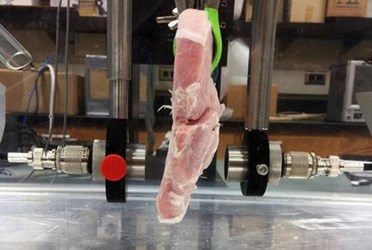Ultrasonic Wireless Signal Capable Of Streaming Video Through Human Body

Implanted devices may one day stream high-definition “Netflix-quality” video from inside the body, said scientists from the University of Illinois, Urbana-Champaign (UIUC). By replacing radio frequency with an ultrasonic wireless signal, scientists have demonstrated a dramatic increase data rates through animal tissue, which would be enough to stream video or control small devices.
Many implants that are capable of wireless communication, such as pacemakers and defibrillators, use radio frequency (RF). But, a University of Minnesota study published in 2011 remarked that RF presented significant challenges in implantable wireless communication and device innovation.
“Wireless RF telemetry requires significant power and suffers from poor transmission through biological tissue,” wrote study authors. “RF telemetry also needs a relatively large antenna, which limits how small the implantable devices can be and prevents implantation in organs such as the brain, heart, and spinal cord without causing significant damage.”
Michael Oelze, associate professor for electrical and computer engineering at UIUC, added that the Federal Communications Commission (FCC) limits implanted medical devices’ bandwidths to 300 kHz, which limits communication to 50 kb/s. Even without these restrictions, said Oelze in a press release, increased RF data rates would require more power, which would heat and potentially damage tissue surrounding the implant.
In comparison, ultrasonic communication can travel further without requiring the same amount of power, and as such, it has been the preferred method of communication underwater because “sound (pressure) waves exhibit dramatically lower losses than RF and can propagate tremendous distances for signals of modest bandwidth,” said Oelze.
UIUC researchers, led by Andrew Singer, believed that they could translate that long-range ocean acoustical research into ultrasonic systems that work inside the body. “You’re a big bag of salt water, with some bones and some other tissues,” Singer told The New Scientist. “Communicating in the ocean and communicating in your body are very similar.”
Their system — documented in a study posted on arXiv.org — achieved data rates of 20-30 MBps through samples of pork tissue and beef liver. Singer noted that these speeds were fast enough to stream Netflix and could potentially control small implants from outside the body.
Capsule endoscopy, such as that provided by Given Imaging’s (a Medtronic Subsidiary) PillCam, is capable of taking still photographs of the digestive tract, but the technology proposed by UIUC would allow physicians to wirelessly visualize the body with HD video in real time, and to adjust the device externally to change the field of vision.
Oelze commented that new applications for wireless implantable technology are expanding every day, and that “the tremendous bandwidth available in commercial medical ultrasound transducers” offers an alternative to electromagnetic (EM) wave radiation and its potential adverse bio-effects.
“These perceived risks can be as important as the actual risks in deterring progress,” said Oelze. “These issues have impeded progress in developing intra-body wireless networks, which would allow devices to communicate with each other through the body and with external devices.”
UIUC researchers intend to present their findings at the 17th IEEE International Workshop on Signal Proccessing Advances in Wireless Communications, to be held this July in Scotland.
